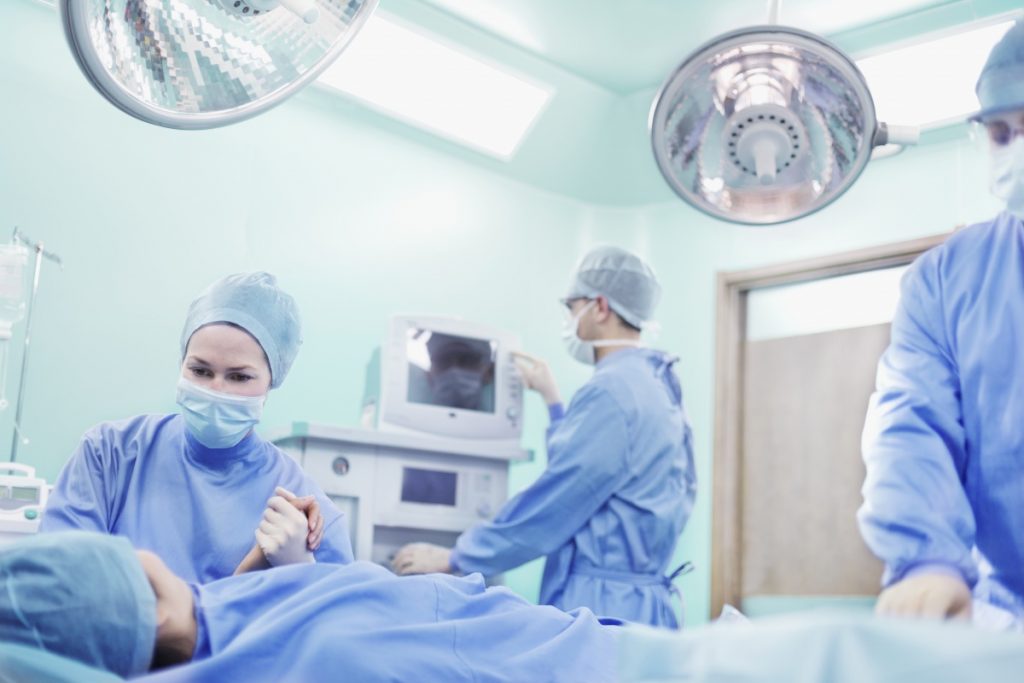Any woman whose doctor told her that she needs a hysterectomy has probably wondered if she should get a second opinion. Granted, a hysterectomy has long been the surgical answer for treating many women’s health issues, including painful uterine fibroids. And by the age of 60, one in every three women will have had one.
But is a hysterectomy really the best option for every woman?
The short answer is no. While having a hysterectomy may be the only choice for some women, it might not be necessary for others—and that may include you. Therefore, getting a second opinion is a good idea.
Signs That You Need a Hysterectomy
A hysterectomy removes all or part of a woman’s uterus and, in some cases, the fallopian tubes and ovaries. Approximately 600,000 of these procedures are performed annually in the United States. It can resolve symptoms ranging from heavy menstrual bleeding, pelvic pain and pressure, to bladder problems and pain during intercourse.
In certain circumstances, your doctor will recommend a hysterectomy because it’s the only option to save your life. A few examples where this surgery is necessary include patients who are suffering from:
- Invasive cancer of the uterus, ovaries, cervix, or endometrium
- Severe Pelvic Inflammatory Disease
- Uncontrollable uterine bleeding
- Complications during childbirth
A hysterectomy can be performed through the vagina, abdomen, or laparoscopically. The latter is when your doctor makes a small incision in the abdomen or vagina and uses a small camera with a thin, lighted tube (trocars) with narrow instruments inserted to remove the uterus. Your doctor may also opt to use a robotic arm to assist in the procedure.

Depending on the situation, your doctor will recommend one of the following.
Three Types of Hysterectomies
- Partial hysterectomy — Your doctor will only remove part of the uterus and possibly the ovaries while keeping the cervix intact. You will no longer be able to have children, though it is possible that your ovaries could keep producing hormones until menopause.
- Total hysterectomy — With this procedure, the entire uterus and cervix are removed. The fallopian tubes and ovaries will likely also be removed in cases where a cancer threat is highest.
- Radical hysterectomy — This procedure is reserved for extreme cases where cervical or uterine cancer is present. It involves removing the uterus, the cervix and its surrounding tissue, and the upper part of the vagina. The fallopian tubes and the ovaries may or may not be removed.
Reasons for Getting a Second Opinion
For many women, a hysterectomy isn’t their only option. In fact, the list of symptoms that can be resolved through medication, playing the waiting game, or undergoing less invasive procedures is longer than the list of complications that require a hysterectomy. This is perhaps the biggest reason why you should get a second opinion if your doctor recommends a hysterectomy. However, your situation may mean that a hysterectomy is 100% essential, especially if you have cancer. And if that’s the case, you should definitely seek guidance on the next steps in your journey.
According to a study published in the American Journal of Obstetrics & Gynecology, as many as 1 in 5 women in the United States whose doctor recommended a hysterectomy don’t need one. Meanwhile, the same researchers found that 37.7% of women included in the study had no documentation indicating they underwent alternative treatment prior to undergoing a hysterectomy. This suggests that many doctors still see hysterectomies as the best—and only—solution for their patients and possibly don’t entertain less invasive options. The truth is, however, that there are alternative options to treat non-cancerous uterine conditions like fibroids.
How do you know if you have fibroids? Uterine fibroids can cause the following conditions and symptoms:
Another factor to consider is that longtime go-to procedures like a hysterectomy are not only surgically invasive, but they are not the right option for women seeking future pregnancies. A hysterectomy eliminates the ability to have children. So, if you intend to expand your family, you will want to wait before having a hysterectomy.

Research also suggests that while a hysterectomy is a safe surgery for the removal of the uterus, women who undergo this surgery are at a greater risk for developing heart disease and other health problems. Heart disease is the number one killer of women in the U.S., more than all cancers combined.
Researchers encourage women to seek a second opinion and consider non-surgical alternatives for treating fibroids and other benign conditions. One reason is because of the high risk of heart disease associated with a hysterectomy, especially if the ovaries are removed.
How Do You Decide If a Hysterectomy Is Right For You?
If your doctor recommends a hysterectomy, the first step is to ask questions. A few key ones include:
- Why are you recommending a hysterectomy?
- What are the pros and cons?
- Is this my only option?
- If this isn’t my only option, what alternatives exist for my specific situation?
- Can I wait to see if my condition improves?
If you are a candidate for a procedure other than a hysterectomy, here are some alternatives to consider:
- Myomectomy — A myomectomy is also an invasive surgical procedure. However, the goal is to preserve the uterus and the recovery time is 2-6 weeks compared to the 6 weeks needed for an open hysterectomy. Therefore, it is widely considered the standard of care for women who need relief from painful uterine fibroids but still want to get pregnant. Most gynecologists insist on C-section after a myomectomy.
- Uterine Fibroid Embolization (UFE) — Sometimes a woman is not considered a candidate for surgery. Or, she is unwilling to have surgery. This is where UFE comes into play, as it is commonly used to treat the symptoms of fibroids without surgery. The best part is that it is 90% effective in treating symptoms. Uterine Fibroid Embolization does not remove fibroids. It cuts off blood supply to the fibroids, causing them to shrink and die—ultimately eliminating pain and heavy menstrual bleeding.
Additional advantages of UFE include:
- No hospital stay and shorter recovery period (one week in some cases)
- No scarring, only a small puncture at the wrist
- Dramatic reduction in fibroid symptoms, over 90% success rate
It is possible to have a normal pregnancy, normal delivery, and normal baby after having the procedure. There is a small amount of research that suggests a slightly higher miscarriage rate if you have a UFE. If a woman has been told that hysterectomy is her only treatment option, we would be happy to discuss the possibility of UFE with her. Read more about fibroids and pregnancy.
- Acessa — This procedure is good if you only have a few fibroids. If you have multiple large fibroids or fibroids that are hard to access, Acessa is not a good choice. It is also not covered by some insurance companies.
- Endometrial Ablation — Typically, the uterus’ inside lining is where heavy bleeding comes from. With endometrial ablation, this lining can be removed by placing a thin instrument into the uterus through the cervix and using heat, laser, electricity, microwaves, or freezing. The downside to endometrial ablation is that it is not safe to get pregnant after you’ve had it. In addition, it will not eliminate any fibroids.
Surgery for Fibroid Treatment: Get a Second Opinion
The decision to have a hysterectomy is never an easy one. For many women, it may be their only option. For others, a second opinion may just be the best decision they ever made.
Medical Director Dr. Suzanne Slonim is an interventional radiologist specializing in Uterine Fibroid Embolization (UFE), a non-surgical procedure that shrinks fibroids and symptoms disappear. She founded the Fibroid Institute and the #FibroidFree movement to relieve women of painful fibroid symptoms and educate them on treatment options other than surgery.
With each UFE procedure, patients are empowered to achieve their full potential without being limited by fibroids. Our fibroid clinics are 100% focused on fibroid treatment in the Dallas and Houston metro areas. With multiple locations, the expert doctors and specialized team at the Fibroid Institute help thousands of women avoid hysterectomy and find relief from their fibroid symptoms.
You will need a formal consultation to determine if you are a candidate before scheduling your procedure. Call for a telehealth or an in-office appointment at our Dallas fibroid clinics at 214-838-6440, Houston fibroid clinics at 713-903-3733, or complete the form below.
Fibroid Institute Texas serves the Dallas and Houston areas including Addison, Carrollton, Plano, Frisco, Craig Ranch, McKinney, Allen, Fort Worth, Grand Prairie, HEB, Arlington, Hutchins, Irving, Duncanville, DeSoto, Cedar Hill, Lancaster, Cockrell Hill, Highland Park, University Park, Park Cities, Garland, Mesquite, Richardson, Dallas, Sherman, Houston, Sugar Land, Katy, Webster, Clear Lake, The Woodlands, Universal City, Spring, Kingwood, Stafford, Conroe, Texas City, Cypress, League City, Bellaire, and more.
*Patient stories are true. Names and/or photos may be changed to protect patient confidentiality.
Prior to starting any new treatment or for questions regarding a medical condition, always seek the advice of your doctor or other qualified health provider. This information is not a substitute for professional medical advice.

